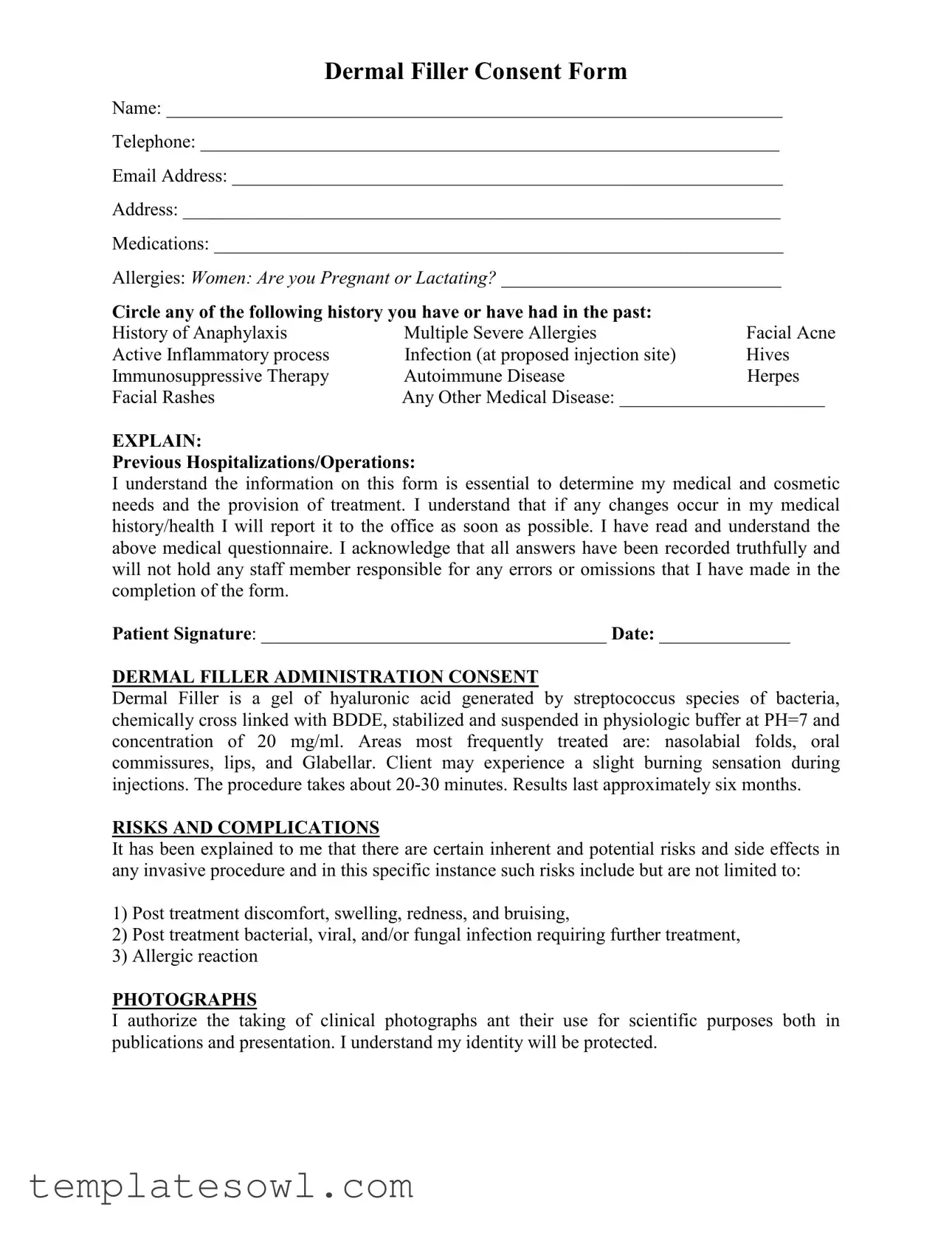Dermal Filler Consent Form
Name: __________________________________________________________________
Telephone: ______________________________________________________________
Email Address: ___________________________________________________________
Address: ________________________________________________________________
Medications: _____________________________________________________________
Allergies: Women: Are you Pregnant or Lactating? ______________________________
Circle any of the following history you have or have had in the past: |
|
History of Anaphylaxis |
Multiple Severe Allergies |
Facial Acne |
Active Inflammatory process |
Infection (at proposed injection site) |
Hives |
Immunosuppressive Therapy |
Autoimmune Disease |
Herpes |
Facial Rashes |
Any Other Medical Disease: ______________________ |
EXPLAIN:
Previous Hospitalizations/Operations:
I understand the information on this form is essential to determine my medical and cosmetic needs and the provision of treatment. I understand that if any changes occur in my medical history/health I will report it to the office as soon as possible. I have read and understand the above medical questionnaire. I acknowledge that all answers have been recorded truthfully and will not hold any staff member responsible for any errors or omissions that I have made in the completion of the form.
Patient Signature: _____________________________________ Date: ______________
DERMAL FILLER ADMINISTRATION CONSENT
Dermal Filler is a gel of hyaluronic acid generated by streptococcus species of bacteria, chemically cross linked with BDDE, stabilized and suspended in physiologic buffer at PH=7 and concentration of 20 mg/ml. Areas most frequently treated are: nasolabial folds, oral commissures, lips, and Glabellar. Client may experience a slight burning sensation during injections. The procedure takes about 20-30 minutes. Results last approximately six months.
RISKS AND COMPLICATIONS
It has been explained to me that there are certain inherent and potential risks and side effects in any invasive procedure and in this specific instance such risks include but are not limited to:
1)Post treatment discomfort, swelling, redness, and bruising,
2)Post treatment bacterial, viral, and/or fungal infection requiring further treatment,
3)Allergic reaction
PHOTOGRAPHS
I authorize the taking of clinical photographs ant their use for scientific purposes both in publications and presentation. I understand my identity will be protected.
PREGNANCY, ALLERGIES
I am not aware that I am pregnant, have any significant Medical diseases, or have any severe allergies.
PAYMENT
I understand that this procedure is cosmetic and that payment is my responsibility.
I hereby voluntarily consent to treatment with Dermal Filler injection for the condition known as: Facial Static Wrinkles. The procedure has been explained to me. I have read the above and understand it. My questions have been answered satisfactorily. I accept the risks and complications of the procedure.
Patient Signature: ____________________________________ Date: _______________
Witness Signature: ___________________________________ Date: _______________
Dental Infiltrate Consent
I, _______________________________ understand that a Dental Infiltrate will be performed to provide
temporary relief of discomfort associated with the administration of dermal filler. I understand that Dental Infiltrates are not 100% effective, but should reduce pain in most cases.
The risks of a Dental Infiltrate include bleeding, infection, and adverse reaction to the anesthetic.
_________ (Initial) I do not have any hypersensitivity to any local anesthetic agents, nor do I have a history of
malignant hyperthermia.
I have read and understand this consent and all of my questions have been addressed and answered to my satisfaction. I have no contraindicating factors, and thereby grant permission for a Dental Infiltrate. I certify that if any changes occur in my medical history/health or regime, that I will notify this office as soon as possible.
________________________________________________________________________________________
Client (Print Name) |
Signature |
Date |
________________________________________________________________________________________
Witness (Print Name) |
Signature |
Date |
